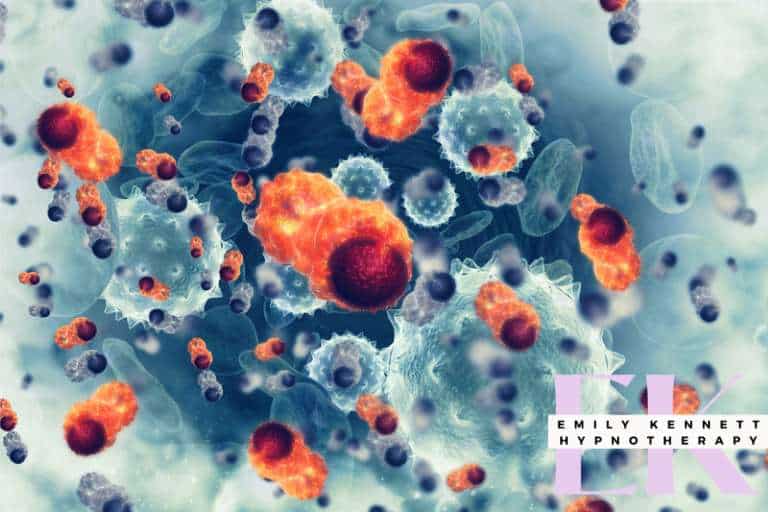
Mast cell activation syndrome, is a condition that is not well understood and a lot more common in women, but why? What’s the link between histamine, menopause and mast cell?
There is a strong link between histamine and hormones. Menopause can kick-start histamine intolerance. This can cause symptoms that you have never experienced before or make existing symptoms more extreme, such as hay fever, asthma and food sensitivities.
So what is the link between menopause and mast cell?
Contents
Oestrogen is a hormone which sends chemical messages around your body. A few of the areas where it can affect health are bone, heart, brain, urinary tract and the reproductive system. It plays a part in ovulation and affects menstruation.
This can cause people who have MCAS to have increased levels of histamine in the body and experience more symptoms during this time in their cycle because of the changes in oestrogen levels, rising normally a couple of days before your period is due and peaking at ovulation.
Then another hormone involved is progesterone. It plays a big role in pregnancy but a few other things it helps with are, a better quality of sleep, turning fat into energy, stabilising your mast cells and helping to stop them from producing histamine; it also plays a role in your mental health.
Progesterone affects the central nervous system and helps with our emotional state. It is also a natural antidepressant that stimulates the limbic system in the brain which manages your mood and makes you feel good.
Oestrogen can stimulate mast cells to break down and release histamine as well as other mediators if the balance isn’t right. High oestrogen causes mast cells to degranulate (break apart) which releases more histamine. The rising histamine levels then produce more oestrogen which then produces more histamine, and the cycle continues.
Another contributing factor which can be causing you to have histamine issues is a histamine-degrading enzyme which is called DAO (diamine oxidase). This enzyme helps break down histamine. Oestrogen can reduce the production of DAO causing histamine problems.
DAO is produced naturally in the body to break down histamine and is responsible for clearing up excess histamine. Your body may not be producing enough DAO in the first place to keep up with the histamine, so the risk of histamine build-up and an overload of histamine is high.
Since oestrogen levels drop during menopause, you may wonder how histamine intolerance can be connected to your menopausal symptoms.
How do menopause and mast cell connect?
As we get older and reach menopause our oestrogen and progesterone levels start to drop, but progesterone drops a lot quicker, which means that if your progesterone is lower than your oestrogen, then there is an imbalance, and this can lead to oestrogen dominance; but it’s not all about oestrogen.
Progesterone plays a big part in this too. If you have a hormone imbalance in your body because you have more oestrogen than progesterone this can be a problem as oestrogen dominance can occur.
Oestrogen dominance isn’t just about having high levels of oestrogen though, it is due to having an imbalance of hormones, so it could be that your oestrogen level is just above the normal range but if progesterone is at the lower end of the range, then this can cause a problem as the hormones are unbalanced.
When oestrogen and progesterone are in balance, progesterone is like the counterbalance to oestrogen when it comes to mast cells and histamine. This is because progesterone sends a message through the mast cell receptors to calm down the mast cells. Progesterone helps stop mast cells from making histamine and helps stabilize mast cells. So, supporting progesterone will help with histamine issues and help to keep things in balance.
You may not be aware, but there are 3 types of oestrogen:
Oestrone (E1) estrone is a form of oestrogen that is produced during menopause. E1 is produced by your liver and fat cells.
Oestradiol (E2) this form of oestrogen is created by your ovaries. It is so important for energy levels, skin and bones. Oestradiol helps by supporting the mucous membrane which keeps the vagina lubricated. Oestradiol is important for your health but too much can increase your risk of breast, ovarian and uterine cancer.
Oestriol (E3) this form of oestrogen is made in your liver and breasts. You have high levels during pregnancy.
So, as you can see oestrogen has many roles and the more oestrogen your body has the more histamine your mast cells will release. More histamine though will lead to more oestrogen and the cycle continues causing oestrogen dominance. Oestrogen dominance can cause a few problems, such as menstrual issues, fatigue, low sex drive, endometriosis, headaches, depression, thyroid issues, uterine fibroids, breast cysts and even breast, uterine and ovary cancer.
The trouble with one hormone being out of balance is that it can put other things out of balance too, one being your thyroid. If you have oestrogen imbalance or oestrogen dominance it will affect the thyroid hormone which can increase your risk of Hashimoto’s, other thyroid conditions and cancer. Although there isn’t currently much evidence out there to support this.
Is there a scientific link between menopause and mast cell?
According to a study by Frontiers in Cellular Neuroscience, thyroid antibodies can attach to the mast cells and when this happens it can activate them. It is also found that your mast cells may be able to store your T3 hormones. This not only means your mast cells are activated and are releasing histamine and other chemicals, but it is also affecting the way your thyroid is functioning and your thyroid levels.
So too much histamine in the body can be down to:
- Too much oestrogen – because oestrogen stimulates mast cells.
- Mast cell activation syndrome – due to too much inflammation in the body, which can be a result of a number of things.
- High histamine foods – such as alcohol, cured meats, fermented foods and fish.
- Bacteria in the gut – this can cause more inflammation and histamine.
The reasons your body may not be able to keep up with the load of histamine can be because of:
- Genes – if your body isn’t producing enough DAO to mop up the histamine.
- Too much Oestrogen – Oestrogen down-regulates DAO.
- Not enough Progesterone – this helps to stabilise mast cells and increases DAO production.
- B6 deficiency – B6 is an essential cofactor of DAO.
So what can be done to help?
Avoiding high histamine foods such as alcohol, fermented/cured meats, certain cheese, vinegar, avocado, bananas, shellfish, bone broth, yeast, dried fruit and certain nuts.
Increasing your intake of B6 which upregulates DAO.
Improving gut health – your gut affects your whole body. Poor gut flora can lead to histamine intolerance, by addressing the issues and getting the necessary tests to find out what bacteria, parasites, Candida, SIBO or leaky gut could be causing your histamine problems, along with an anti-inflammatory, low histamine diet, a diet rich in greens, vegetables, fruits, healthy fats, Organic meat, herbs and spices.
Reducing stress – stress can be a major factor in histamine intolerance and hormone imbalance. Taking time for yourself is so important, even if your life is particularly hectic. Just a few minutes a day can be enough to help you ‘reset’ yourself.
Learning breathing exercises to calm your nervous system, meditation, hypnotherapy, yoga, spending time with friends or family or being out in nature. Anything to reduce your stress and anxiety will keep your body more balanced to stop flares from arising.
Sleep – a good night’s sleep is so important for reducing hormonal imbalance and histamine intolerance. If you are not getting enough rest, then this will put extra stress on your body which already has enough to cope with. Take time in the evening to unwind, have an Epsom salt bath, read a book or keep a diary so that you are not going to bed with a busy mind. Listening to hypnotherapy to help relax you into a restful sleep. Always aim to get around 8 hours. This benefits both menopause and mast cell.
Look at balancing hormones, and reducing oestrogen. Working with a functional practitioner can help you with this and look at natural progesterone, which will help stabilise mast cells and help us regulate the DAO enzyme. Keep in mind, though, that we’re talking about natural or bioidentical progesterone here. Synthetic progesterone medication doesn’t usually have the same mast-cell calming effect.
You may think about balancing hormones with hormone replacement therapy, but for some this can cause more problems, increasing the risk of Oestrogen dominance and histamine issues. Synthetic hormones can be particularly hard on mast cells. Bio-identical hormones can be better with fewer risks, but do your research or find a functional practitioner who can help with menopause and mast cell.
Please remember that this is just a guide from what I have found out through my own experiences with menopause and mast cell, I have no medical qualifications, so please consult with your GP before stopping any medication for menopause and mast cell.
